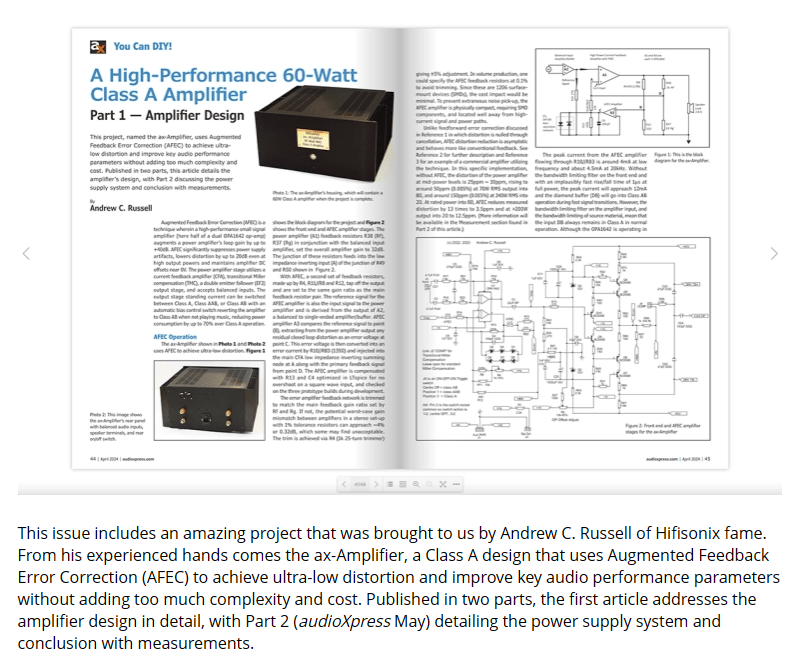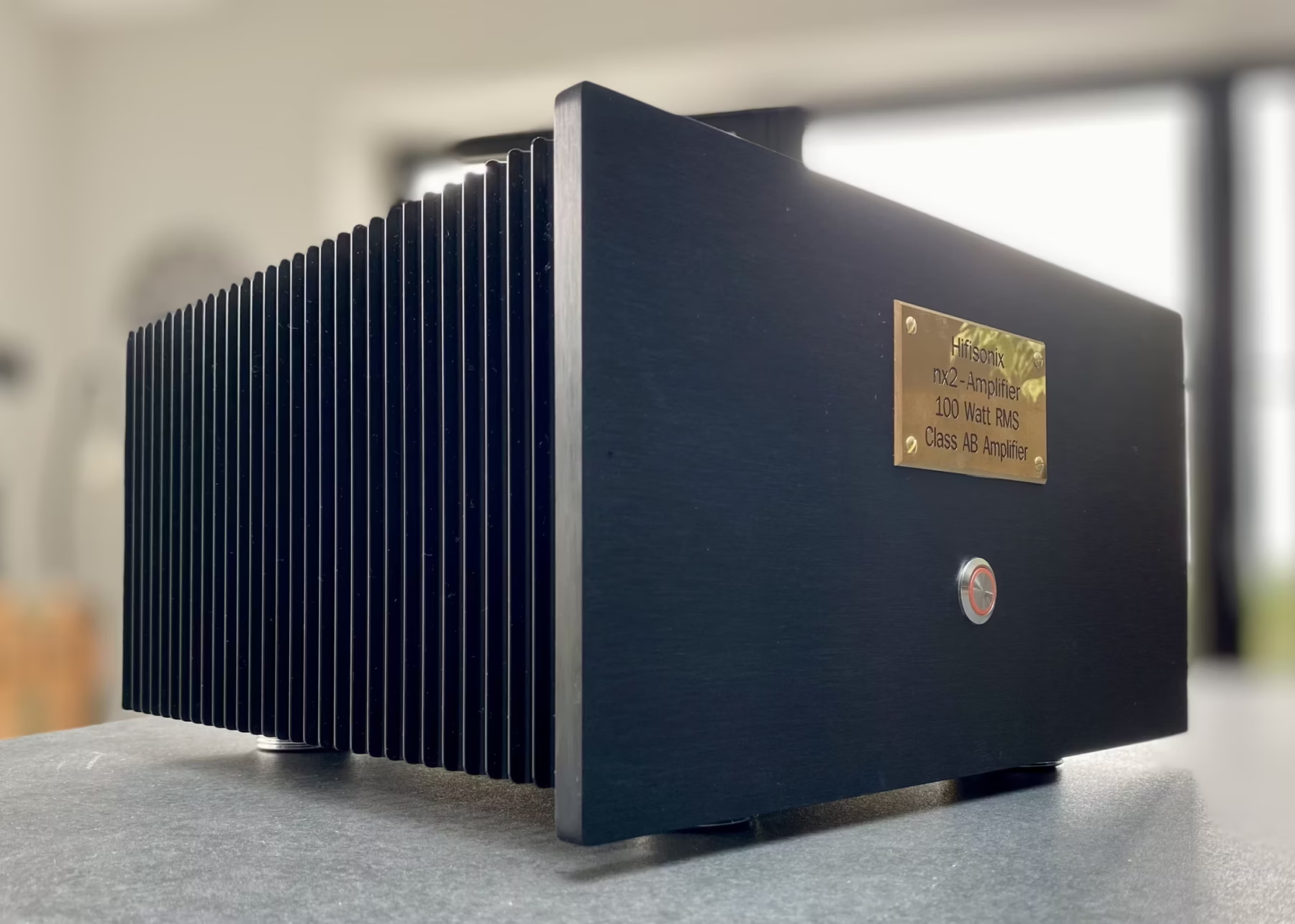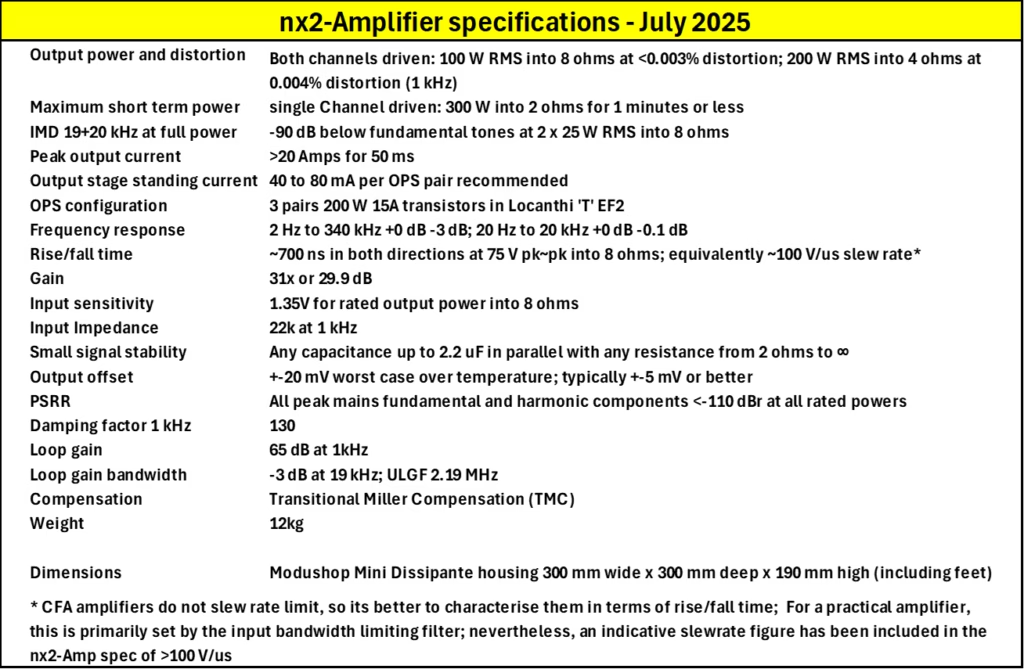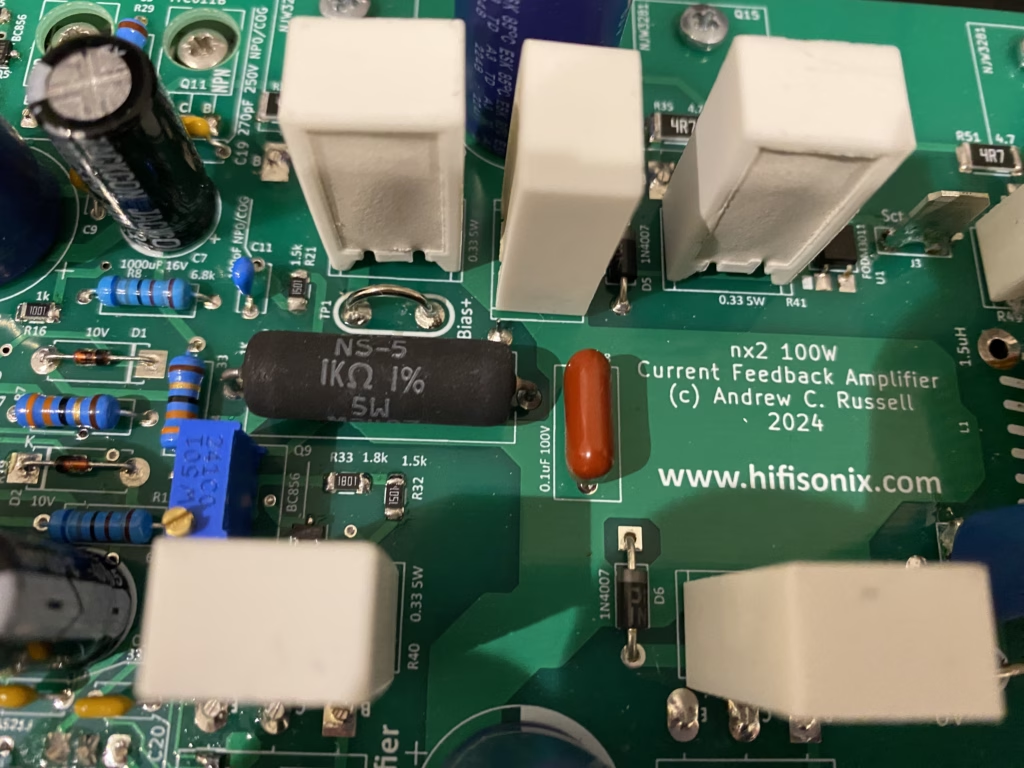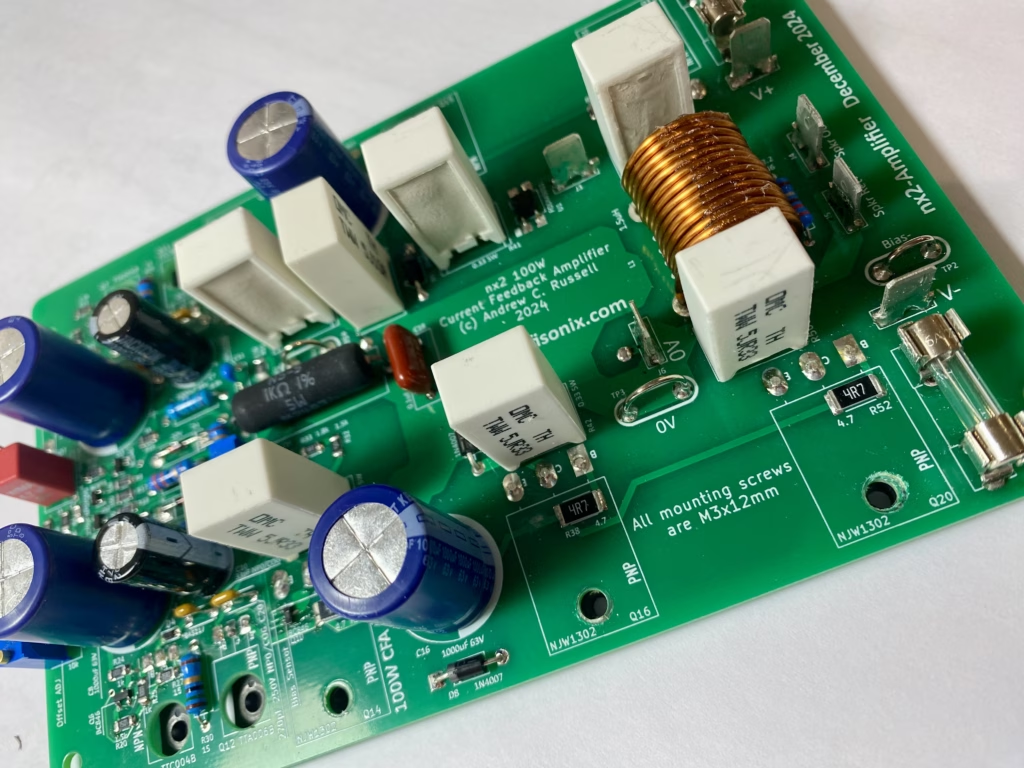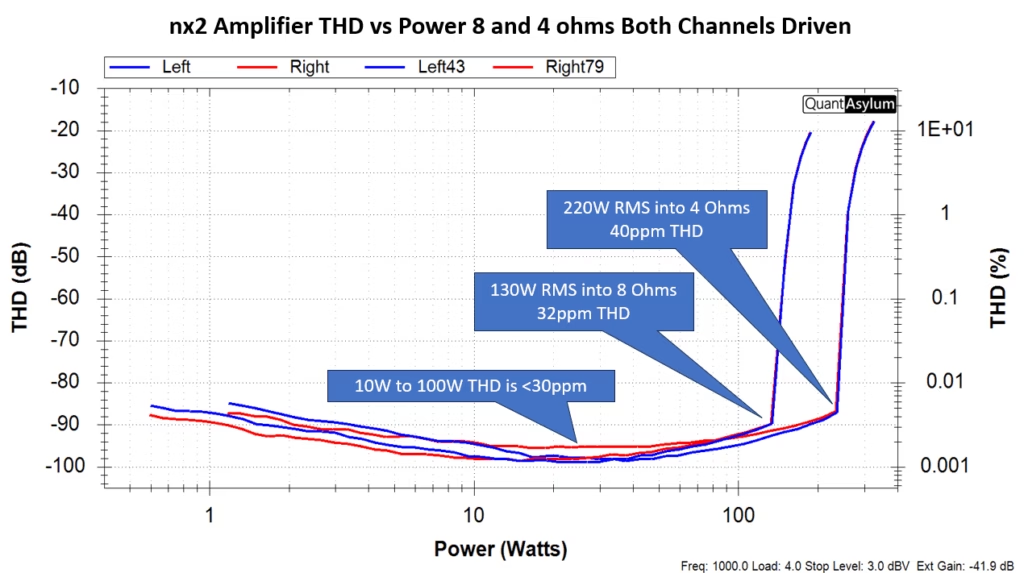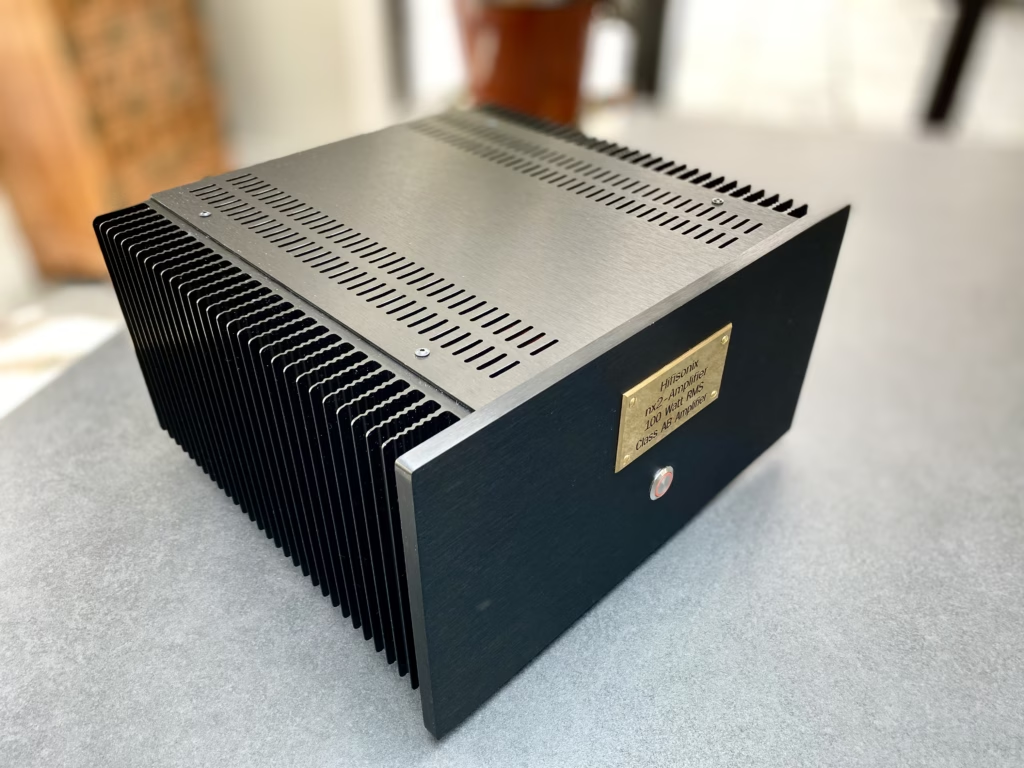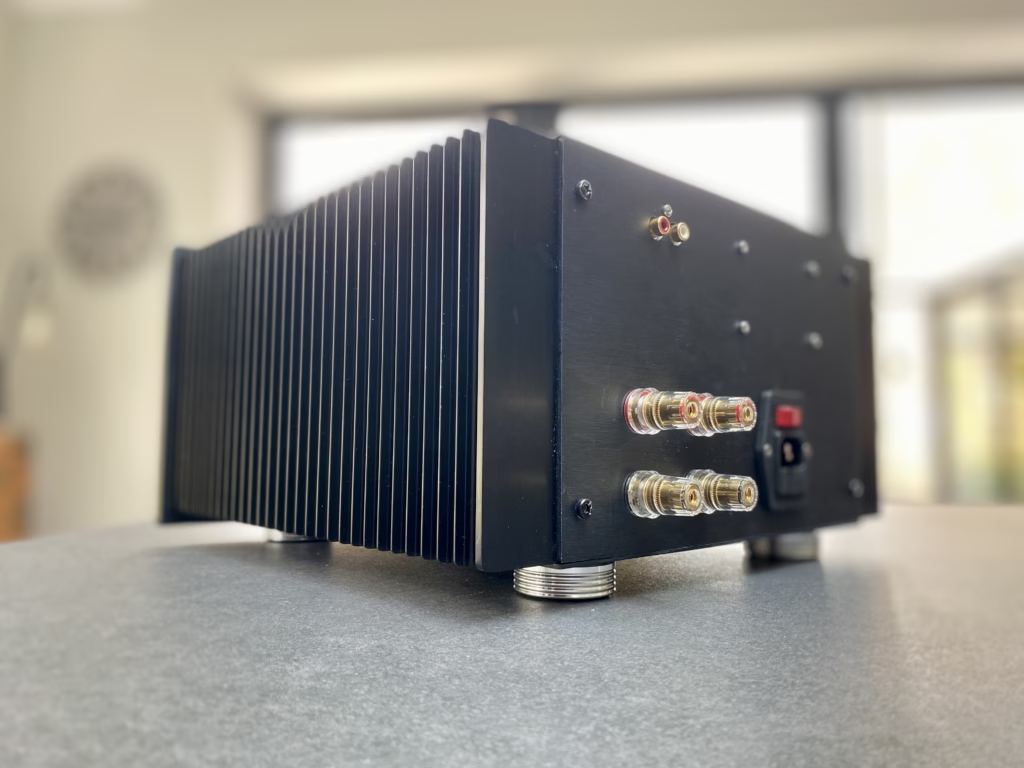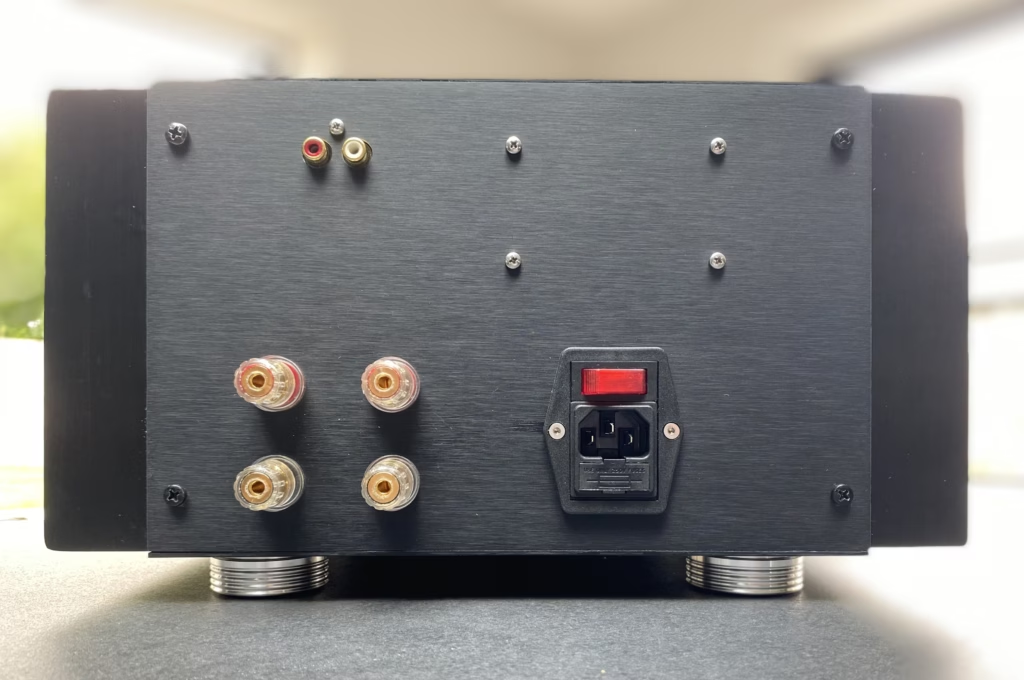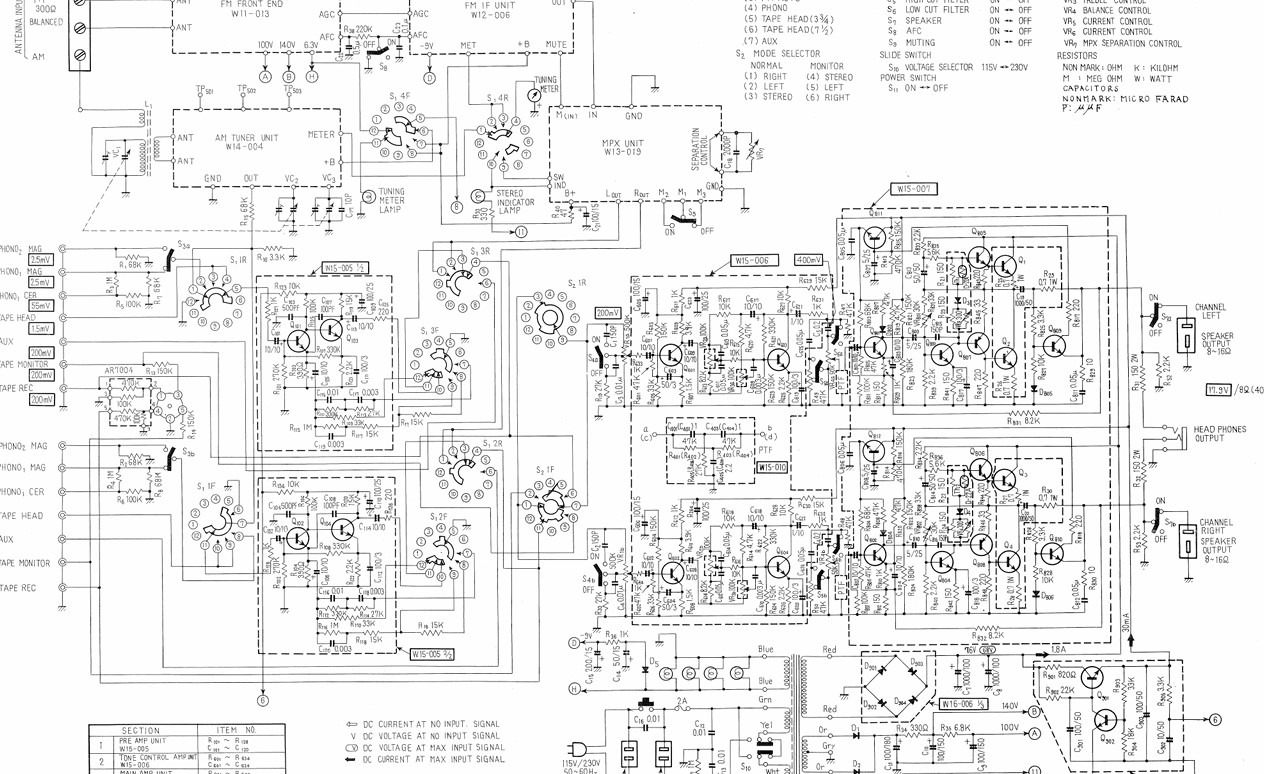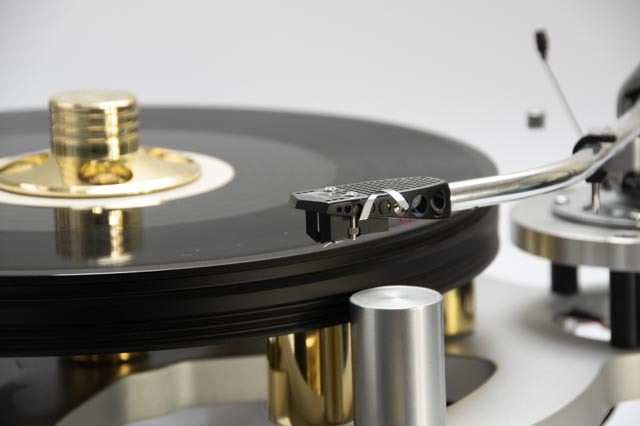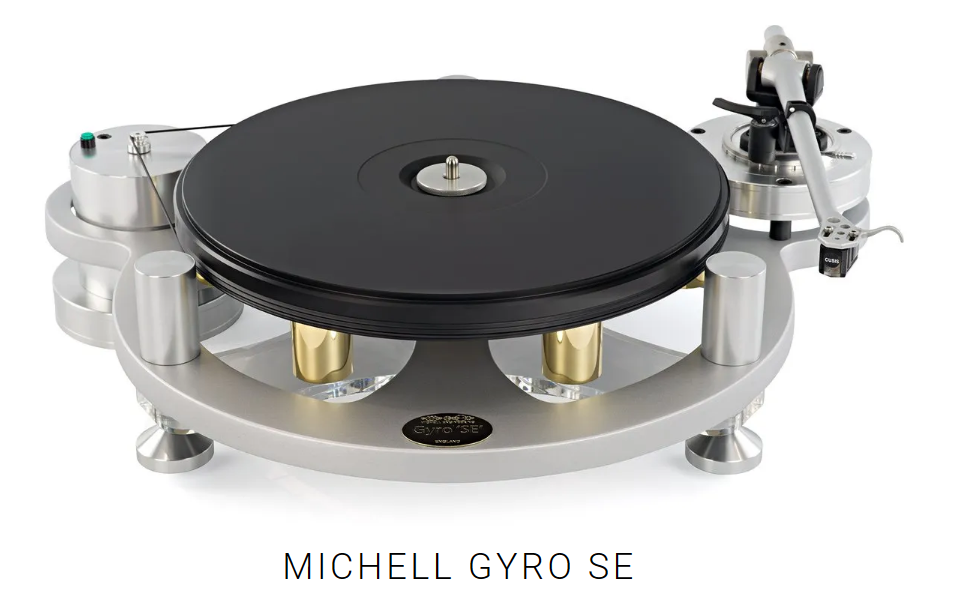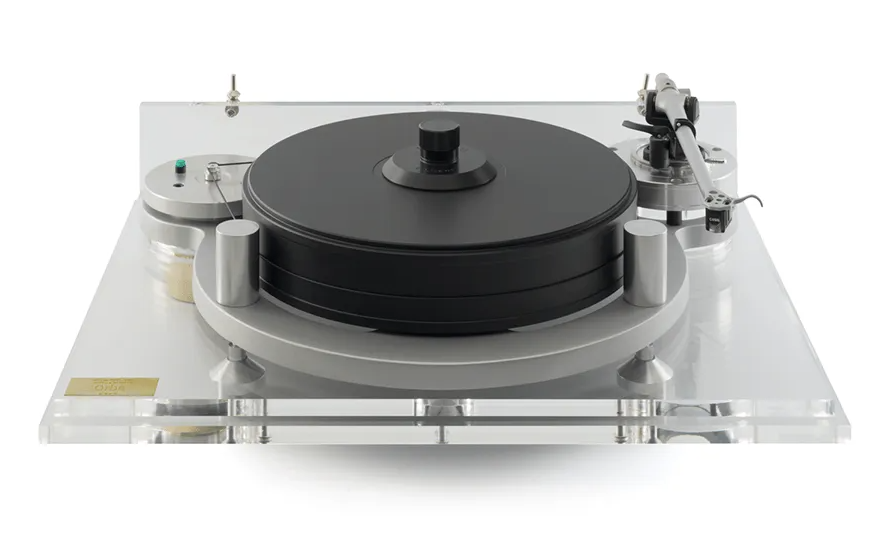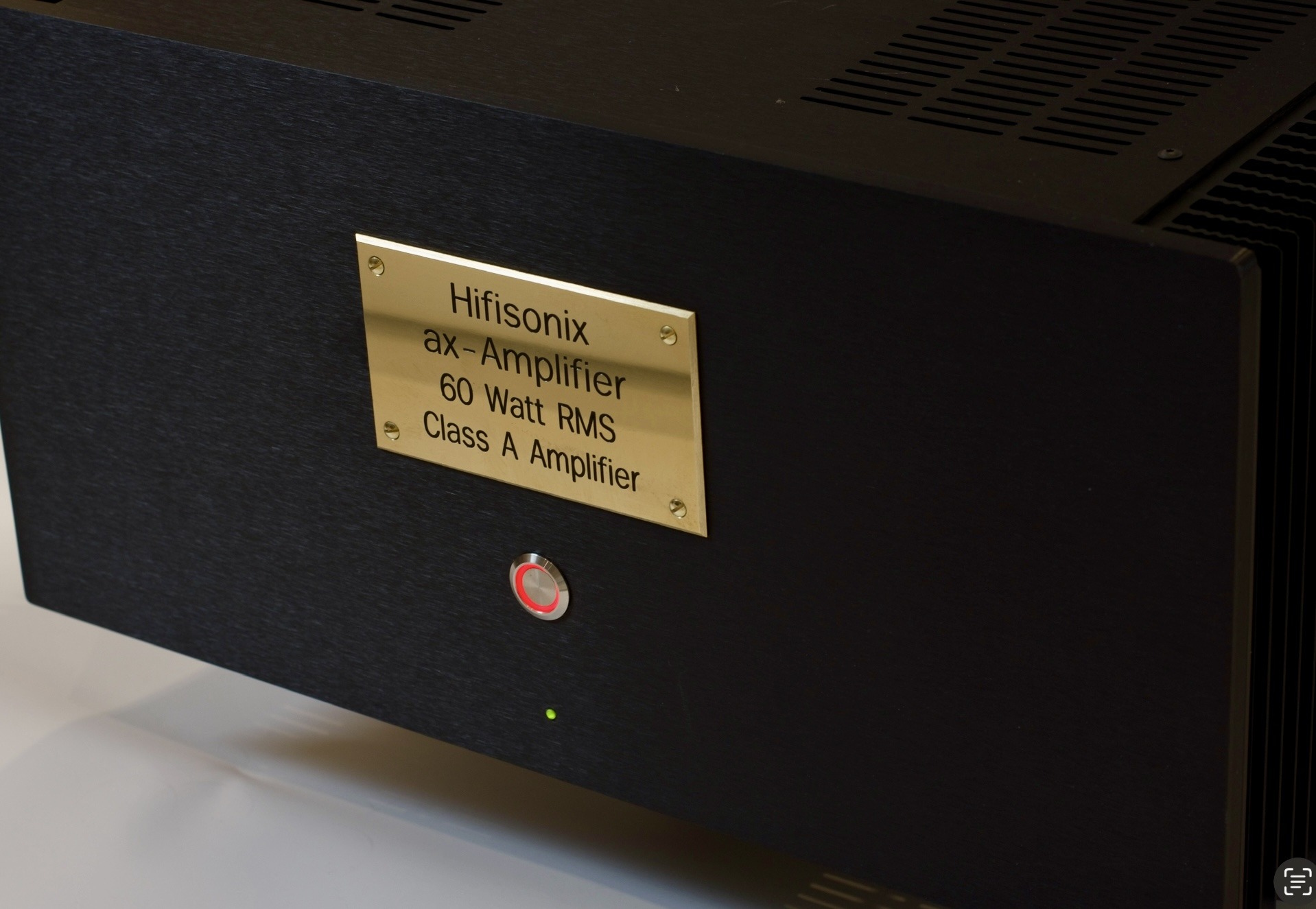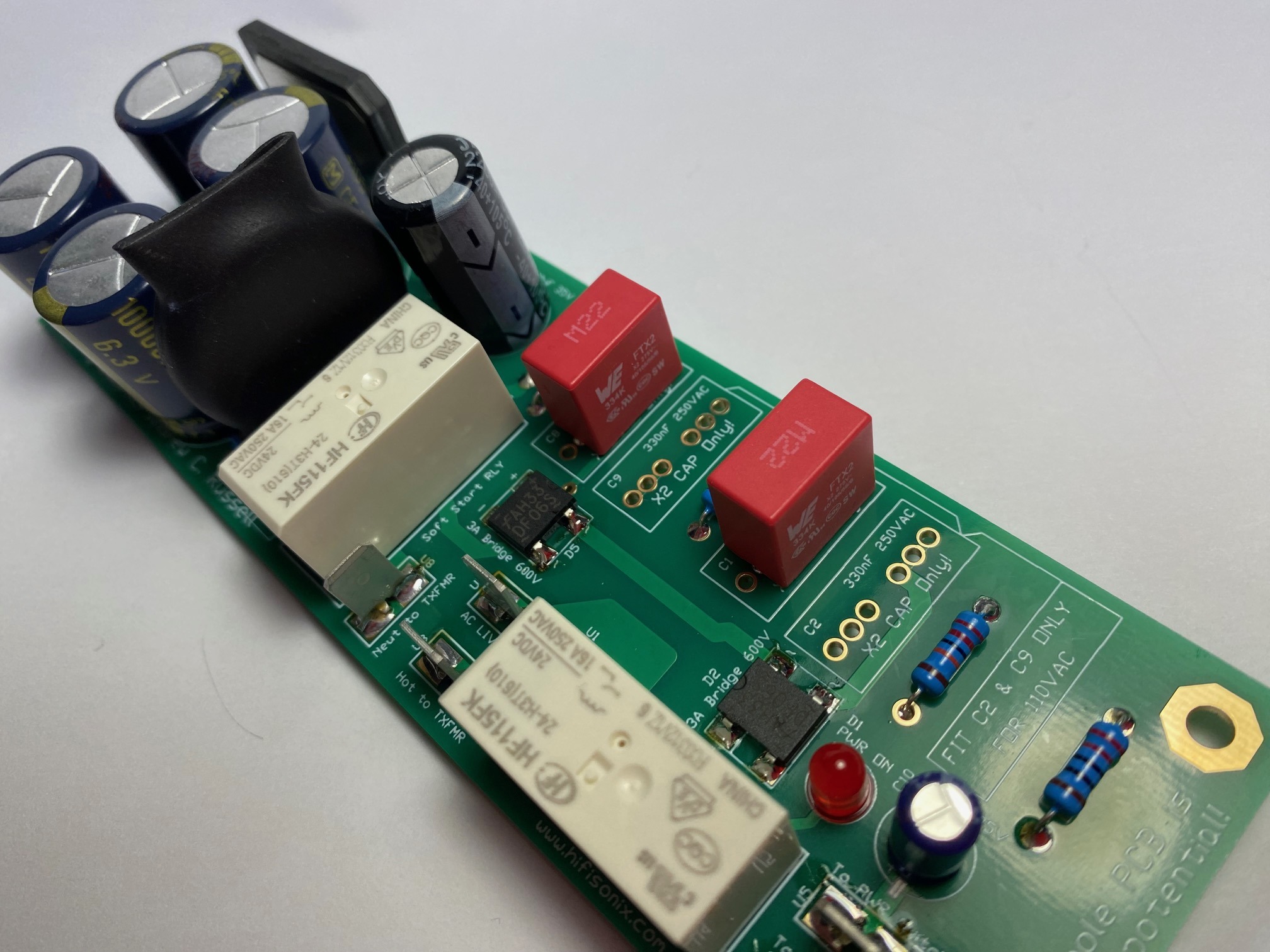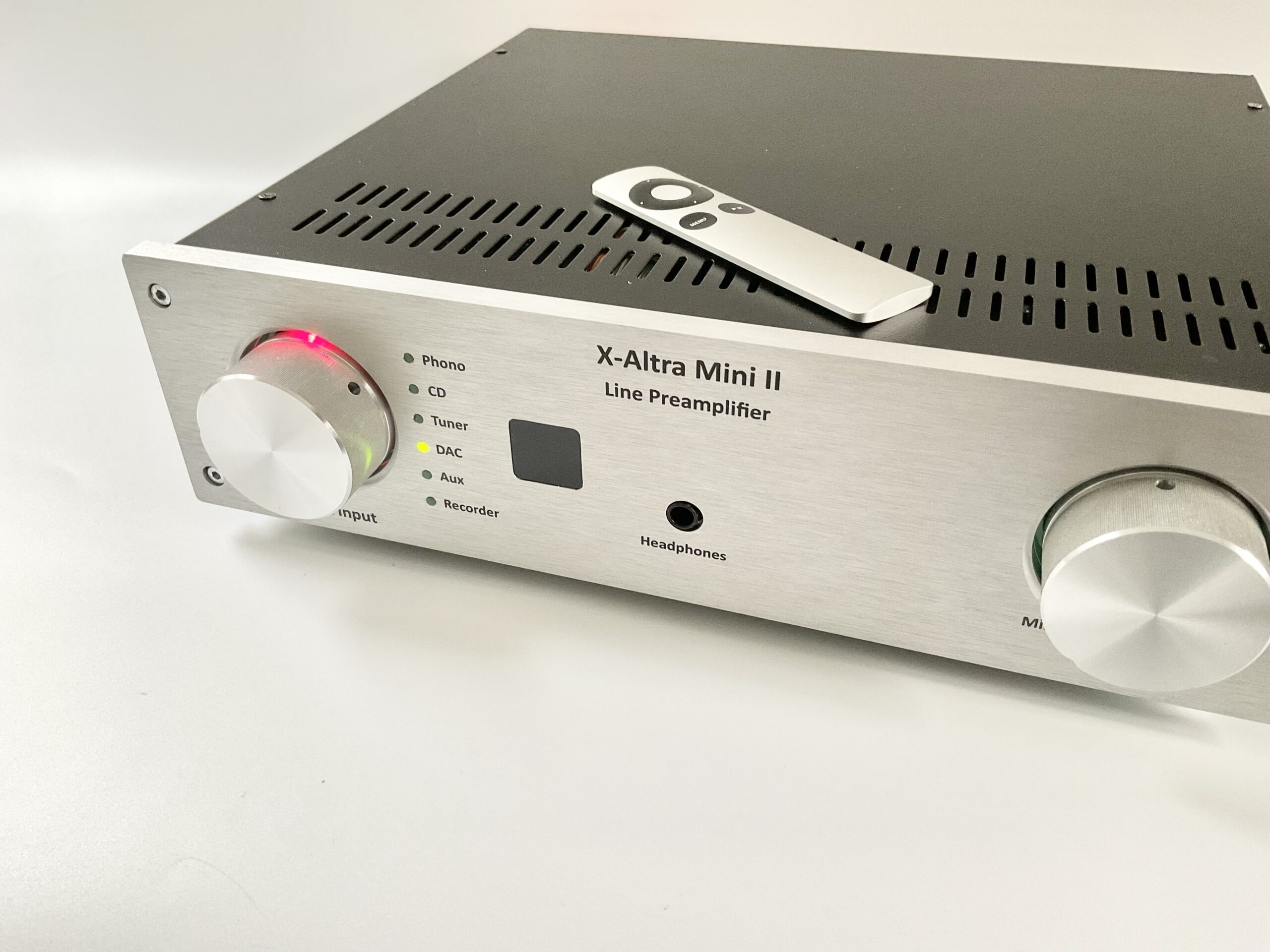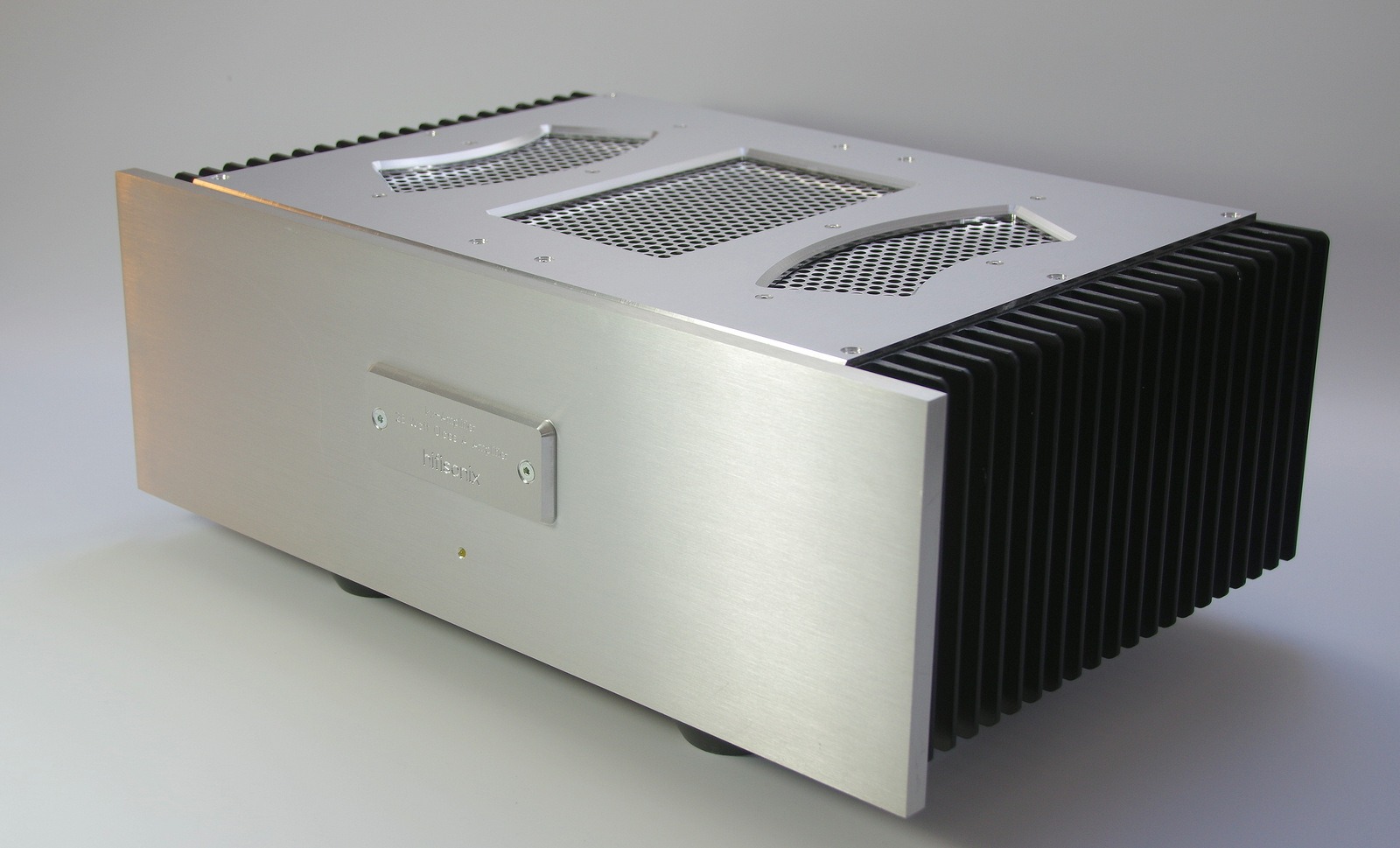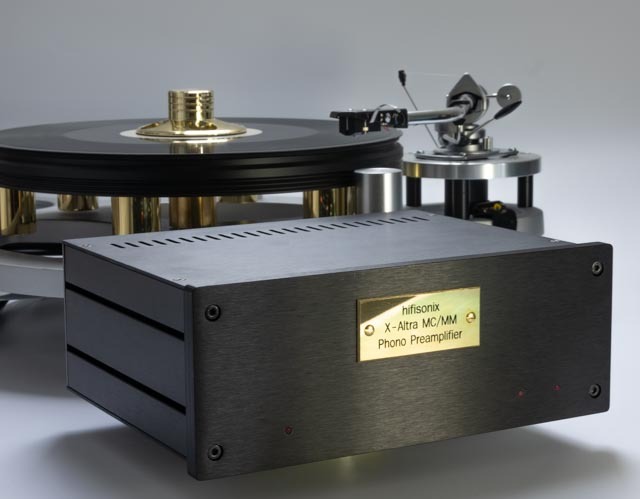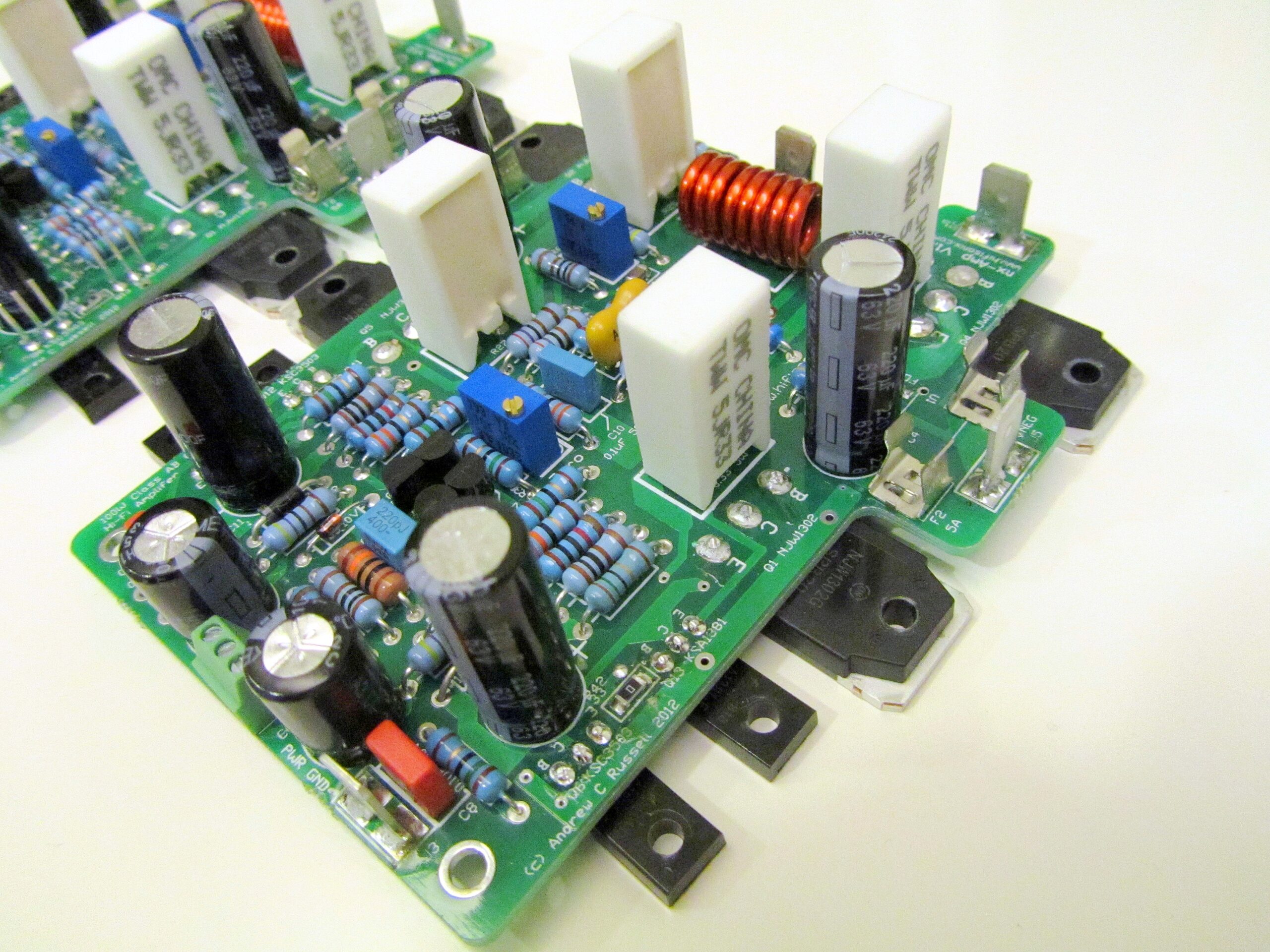Originally published in August 2012.
Click here to order a set of DS THP PCBs for the sx-Amplifier from Jim’s Audio
About 150 sx-Amplifier PCB sets have been sold, with most of those going on to be built. As you can read about in the PDF below, my class A journey started off after listening to an ancient Musical Fidelity A1 that I repaired for a friend while living in Taiwan. I’ve had many emails from sx-Amp builders who have loved the sound, despite this being a very simple and not particularly low distortion amplifier. If you are new to DIY audio, this is probably a good as any place to start.

The hifisonix sx-Amplifier is a low component count current feedback topology (CFA) design that delivers 15W RMS in class A into an 8 Ohm load (about 25W peak in class A) and around 25W RMS into 4 Ohms in class AB mode. The design uses readily available components, achieves very wide bandwidth, along with fast rise and fall times. Distortion is low compared to competing designs (e.g. JLH’s 10 Watter from 1969, or Jean Hiraga’s 20 W class A), thanks to the availability of modern bipolar devices, and the use of LTSpice to optimize the design.
You can down load the full pdf article here The-sx-Amplifier-V2.10
Here is an Excel file that contains the BOM lists, including Mouser part numbers for the sx-Amplifier (covers both the double sided THP PCB version ABOVE and the new single sided PCB version discussed ): –
Click here for the BOM that covers all PCB versions
I have had a lot of requests for PCB’s and/or people indicating they would like to etch their own boards. To support these requests, I’ve created a second layout that is singled sided and more amenable to home etching. (The PDF file scale is 1:1):
SS sx-Amp Bottom Copper
Here is the component overlay for the single sided sx-Amp SS sx-Amp Top Component Overlay
Here are the Gerbers for the single sided sx-Amp Single sided sx-Amp Gerbers
Pop Alexandru, also known as Alex MM on diyAudio.com has also kindly produced a set of single sided PDF layouts below that closely follow my DS THP version. He has produced both mirrored and non-mirrored versions. His boards are neater than mine! Thank you Alex!
SX-AMPLIFIER TOP SILK SCREEN MIRRORED
SX-AMPLIFIER SINGLE SIDED COMP OVERLAY
SX-AMPLIFIER SINGLE SIDED BOTTOM
SX-AMPLIFIER SINGLE SIDED BOTTOM MIRRORED
Note: there are no single sided PSU layouts. If you build the sx-Amp using single sided PCB’s, and your own PSU, do not forget to fit your finished amplifier with a Zobel network of 0.1uF and 10 Ohms in series from J7 to the 0V star ground on your PSU. If using the DS THP PSU board from Jim’s Audio, the Zobel network is located on the PSU board. Just follow the wiring up instructions in the writeup.
Note: the component numbers and BOM list are all the same for the single sided PCB but with the following changes: J2 is removed. C2 becomes a 16V 10uF through hole capacitor (C1 remains a 1206 10uF 50V MLCC SMD device); Q3 becomes a BC547C.
If you have any questions or concerns, please post your comment up here, or on the DIYaudio forum here: https://www.diyaudio.com/forums/solid-state/236522-sx-amp-nx-amp.html
Here is diyAudio member Thimios from Greece showing his fantastic sounding sx-Amplifier
https://youtu.be/Jf8HHAS6Q9s
_____________________________________________________________________________
The sx-Amplifier: A 15 W Current Feedback Class A Amplifier
Jean Hiraga’s 20 W class A design became something of a cult amplifier in the 1980s in the audio community and constructors from Europe, Australia, Japan and the USA praised it’s sonic performance. In that design, Hiraga used a much simplified (I’d call it sparse, or ‘stripped down’) current feedback amplifier (CFA) topology and low feedback to create an amplifier that was described somewhere as sounding ‘liquid’ and ‘tube-like’. Hiraga has always been noted for his minimalist, idiosyncratic designs, and comments about the sonics aside, I was attracted to the simplicity – only 8 transistors in the original and a handful of discrete components (excluding the power supply of course) for a complete class A amplifier. Distortion was by any standards very high, topping out at about 1.8% at the rated power into 8 Ω, although he seems to have indicated it was of the ‘good variety’ due to its harmonic structure. However, Hiraga’s amplifier (rated at 20 Watts per channel into 8 Ω) was the product of 1980’s know-how and device technology. I found myself wondering what I could cook up with today’s components and the insights afforded by circuit simulation tools that were unavailable back in the early eighties. I did quite a bit of research on Geoff Moss’s excellent ‘the class A amplifer site’ (tcaas) and Rod Elliot’s ESP site and the Death of Zen (DoZ) amplifier, modelled after JLH’s classic 10-Watt design from 1969. Compared to the 1980s, we now have some really good power transistors, and there is no shortage of cheap good quality small signal devices either, other than the ultra-low noise small signal bipolar and JFETs from Toshiba in Japan of course, which are now discontinued.
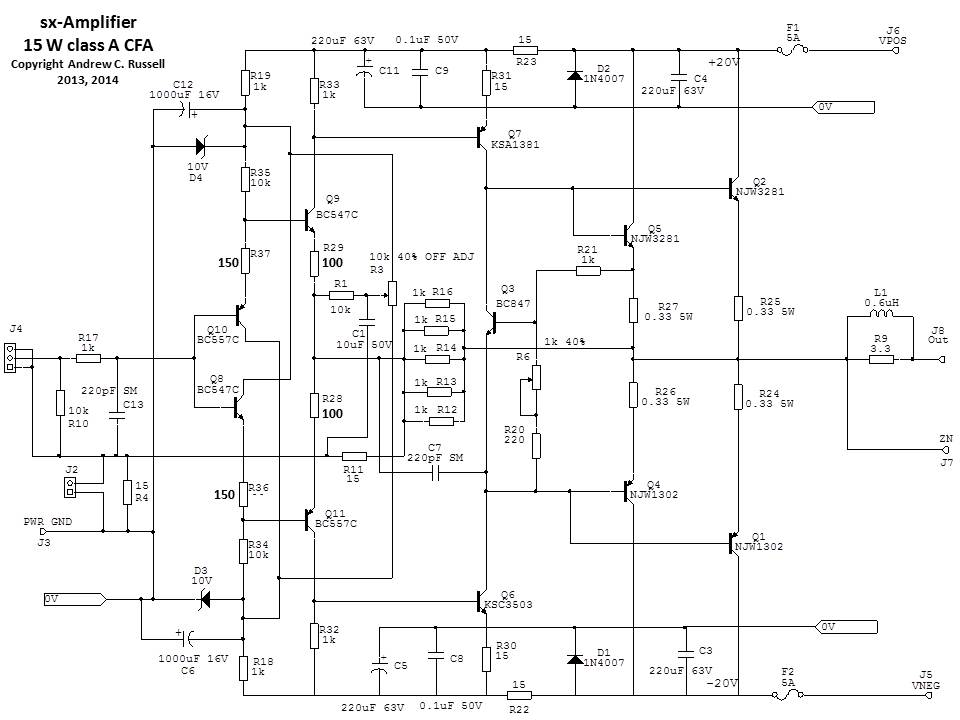
Looking at the reprint of JLH’s original 1969 10 W class A design, it is immediately apparent that the distortion vs. frequency graph at 9 W output is flat all the way out to the measurement limit, which was beyond 20 kHz. In a conventional Voltage Control Amplifier (VCA) class AB topology, when driving a load that causes the output stage to exit the very narrow class A bias region (ideally set at .026/Retot where Retot is the total output transistor emitter degeneration resistance including the reflected base resistance and typically ranging from 0.1 Ω through to 0.47 Ω), distortion kinks upwards at 40 dB/decade, with the kink point a few hundred Hz up to a few kHz. Distortion increases at 40 dB/decade, arising from the fact that the amplifier loop gain beyond the -3 dB point is decreasing at -20 dB/decade, while the THD contribution doubles with every octave because with every doubling of frequency, there is a doubling of cross over events, and hence distortion.
The shape of the distortion curve over frequency tells us something about the nature of class AB amplifiers when required to move from their class A region into class B – feedback can only do so much to reduce the distortion, and if that feedback (loop gain) is already decreasing at 20 dB/decade within the audio band, you simply have to accept the uptick in the distortion vs. frequency plot. JLH’s output stage design was class A of course, and so did not have to contend with crossover distortion, and this is the fundamental advantage of class A over class AB. The major distortion component in any competently designed class AB amplifier is the crossover distortion, and if that can be removed as a factor, there are significant performance and sound benefits to be had. At low frequencies (i.e. below about 30 Hz), the distortion on JLH’s amp rose rapidly because of the electrolytic coupling cap between the output and the speaker. Later enhancements of his design did away with the output coupling capacitor at the expense of a split rail supply and output offset adjustment.

The sx-Amplifier is a thoroughly modern take on the class A genre that employs CFA topology, 30 MHz Ft output devices and features a – 3dB bandwidth of 540 kHz, along with slew rates of 140 V/us. This is a very smooth sounding amplifier, suited to jazz, classical and acoustic material in general which should be married to speakers with efficiencies of 92 dB/W or better if one is after realistic concert hall sound levels – however, I used mine whilst in Asia with my B&W 703’s, which are rated at 89 dB/W, in a modest sized listening space and found that satisfactory volume levels were easily attainable.
In the design you see here, I had the transformer specially wound by ‘PowerStar’ in Taiwan and it features a screen and GOSS band for the best noise performance. Careful attention to layout and wiring have resulted in an exceptionally quiet amplifier. What does it sound like? As mentioned earlier, this amplifier is best suited to classical, jazz and acoustic material – because of the limited power on tap, its not really suited to rock or material that demands high power.
The photograph below is of the second build I did of the sx-Amp.

This is the sx-Amp I ended up using up until the kx2-Amp arrived some 10 years later in 2022. Incidentally, I built one of the nx-Amplifiers into a similar chassis.
I have to admit I started this project with some apprehension about what a small amp would sound like – especially since I am used to listening to a big amp (250 W per channel which you can read about here Ovation 250 Amplifier and a 180 Watter called the e-Amp ). Why design a 15 W class A amplifier, and especially one that is decidedly minimalist, after two big, complex, powerful, high performance ones? Well, there are a few reasons. Firstly, designing single digit, or sub 1 ppm distortion amplifiers can provide a rewarding intellectual experience, if only to later be thwarted by practical execution that impacts both performance and build aesthetics. Secondly, reductions in distortion below about 0.5% offer little or no further improvements in the perceived sound quality of an amplifier in controlled testing and there is a lot of academic material in support of this contention. Anecdotally, Nelson Pass has built a name for himself with class A amplifiers that for the most part never see the south side of 0.1%, and yet are highly rated by the cognoscenti. What about power levels? Big amplifiers sound wonderfully at ease with themselves – they are unflappable and handle music dynamics well. Low power amplifiers, like the sx-Amp under discussion here, really need to offer something unique to justify the effort in construction, and exploring this territory is the 3rd reason for undertaking this project: is there a magic class A sound that makes building something like this worth it?
Speakers are notoriously non-linear often 2 to 3 times higher than the 0.5% I quoted above. Now, none of this can serve as an excuse for badly designed, sloppily engineered, high distortion amplifiers. We know that the ear is much more sensitive to some types of distortion (crossover for example) and to higher order harmonic content in particular. If these things are taken as considered inputs into the design process, we then have some latitude in design philosophy: Challenging, all out, ultra-low distortion designs, or something a little less demanding, but that ticks all of the right boxes given our knowledge about how the ear/brain system works and therefore sounds good because we avoid the major pitfalls, and is FUN TO BUILD! This is exactly where the sx-Amp is positioned.
Once testing and set up were completed, I was very excited to hear what this thing could do. For initial listening I chose a few classical CD’s – a Lexus classical CD (freebie), Julian Bream ‘The Ultimate Guitar Collection’, a wonderful ‘LSO Live’ sampler from Hi-Fi News, A Philips Sampler from the 1990’s ‘Introducing Mozart’, followed by two jazz CD’s: Michel Petrucciani’s ‘Both Worlds’ and ‘Time Out’ from The Dave Brubeck Quartet.

Pictured above is the very first sx-Amplifier I build in 2012 while living in Japan
I’ve had a Hi-Fi News LSO sampler for about seven or eight years. The tracks date from performances made between 1999 through 2002. All tracks superbly recorded with tremendous space (holographic) and dynamic range. The sx-Amp produced a wonderful three dimensional sound stage that extended well beyond the speakers, very deep and layered front to back. If you are ever looking for a classical demo CD – this has to be it! To be sure, a big part of this is the quality of the recordings, but no doubt the class A magic also played an important role in what I was hearing. Strings have that ‘bite’ to them in their lower registers and the top end shimmers marvelously; brass has the leading edge snap followed by the tizz that you only get from a really good recording played through a sympathetic signal chain. The top end on this amplifier is very beguiling without any hint of harshness and the overriding sensation is one of smoothness and relaxed detachment. The scale on the Brahm’s piece (‘Denn Alles Fleisch Est Wie Gras’) was very well reproduced which was surprising to me given the fact that only 15 W was on hand.
Up next was a double CD collection of Julian Bream recordings covering the four decades from 1959 through 1982. Some of the early recordings are a little noisy (tape hiss) but the sound is very spacey and the notes wonderfully rounded and resonant. My favourite is disc 2, which was recorded in 1982/83 and consists entirely of solo guitar and lute pieces. Here again, the sound staging and recording venue are beautifully captured and easily re-created by the sx-Amp.
Philips – when they were still in the music business – released a huge Mozart collection in about 1992 or ’93 and I’ve had the collection sampler about 20 years. There are 19 tracks and the recordings vary from good to outstanding. One of my favourites is the horn concerto in E-flat. I think Sir Neville Mariner’s recording is one of the best – the horn really floats out above the orchestra and the reverb and scale of the recording space make for an incredibly immersive experience. The whole piece is energetically played – I have found some other recordings, because of the arrangements and the conducting no doubt, to be laborious, plodding and acoustically flat by comparison. This recording is one of the better ones on this CD – I think some of the tracks are a little bright (maybe that’s just because it’s Mozart!), but the horn concerto is beautifully balanced. The sx-Amp presented a very smooth, rounded sound with no hint of harshness. The layering front to back was very precise, and the left to right sound stage wide, though not as far beyond the edges of the speakers as the LSO CD – a wonderful listen however.
Dave Brubeck’s ‘Time Out’ always amazes be because it was recorded in 1959 (like some of Julian Bream’s recordings mentioned above) and you can hear the tape hiss and one or two other minor imperfections, and yet the sound is absolutely palpable. This is a re-mastered re-release but is has lost none of the quality of the original. The cymbals, always a very difficult sound to reproduce accurately, are as smooth as silk and seem to hang in the air – I’ve heard more recent recordings where they sound flat and lifeless by comparison. Paul Desmond’s alto sax and the bass, played by Eugene Wright, have some wonderful space around them on ‘Strange Meadow Lark’, one of my favorite tracks on this CD. The sx-Amp is able to convey the sparseness of the music, and the recording, reproducing the very wide and deep sound stage – very three dimensional. Again, as with the other recordings, there is a sense of a very relaxed, effortless, smooth sound.
Most of the tracks on Michael Petrucciani’s ‘Both Worlds’ are spaciously recorded and the sound staging is good. The sx-Amp again did a great job of conveying the space around the musicians. There are a few tracks where the brass is set well back in the mix and this lends great depth to the recording, although in general the sound stage is not particularly wide. I was pleased to discover the sx-Amp could give the same sensation of depth as the Ovation 250 and the e-Amp, which offer a first class listening experience in this regard.
I have not said much about the bass performance of this amplifier. You’d expect a 15 W amplifier like this lack the scale of higher power examples, but I was pleasantly surprised at how realistic the bass reproduction was. Importantly, it had weight and the notes were well sustained. I’ve heard a lot of systems where the bass is very lumpy. No doubt the speakers and recording play a role here, but if there are any shortcomings in the amplifier’s ability to reproduce bass notes exactly as they are recorded, or drive the speakers effectively, you can bet the overall sound is going to be disappointing. Bass plays an important part in imparting space and weight to a piece of reproduced music – this is one of the reasons sub’s often seem to bring a system to life, despite the fact that they are producing little or no acoustic output above 100 Hz or so.
My B&W 703s are moderately efficient at 89 dB/W, and they are a relatively easy load to drive, so getting reasonable SPLs out of this set up is doable. The sx-Amp output stage is hefty, so up to the limits of the power supply voltage, it has no problem delivering plenty of current when required.
Of course, this is not an amplifier for a ‘head banger’ music set-up – the sx-Amp is better suited to jazz, classical chamber and acoustic music. If you want 3D sound staging and shimmering highs on strings, this amp does it. If you have some efficient horns or suchlike (96 dB/W and above), then 15 W is going to allow you to get realistic orchestral levels, although I never found this to be an issue on the material I tried on my speakers as described above.
The sx-Amp achieved all of the goals I set out when starting this project: a simple design using modern, readily available components with wide bandwidth and speed (i.e. fast rise/fall times). The design goal called for wide loop gain, which was achieved through the selection of the CFA topology. I was not expecting any huge surprises sonically, but after completing a few hours of listening tests, I can say the sx-Amp is wonderfully smooth, open and has a very relaxed, non-fatiguing sound – not what I was expecting at all, and a really pleasant surprise.
The earlier designs from JLH and Hiraga are highly regarded and as of 2025, JLH’s is over 55 years and Hiraga’s close to 45, but they have clearly stood the test of time as constructors return time and again to their simplicity, circuit elegance and sound. Nelson Pass’s mosfet based designs, some of which date back 35 or 40 years, feature simple, elegant circuits, and much of the effort is focused on the harmonic structure of the distortion – his class A amplifiers are also legendary within the DIY community and noted for their sonics.
I hope that the sx-Amp joins this august group of DIY amplifiers, and emerges as a ‘modern take’ on what is ultimately a very specialist and esoteric audiophile segment: minimalist low power class A amplifiers that focus on listenability.
